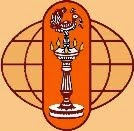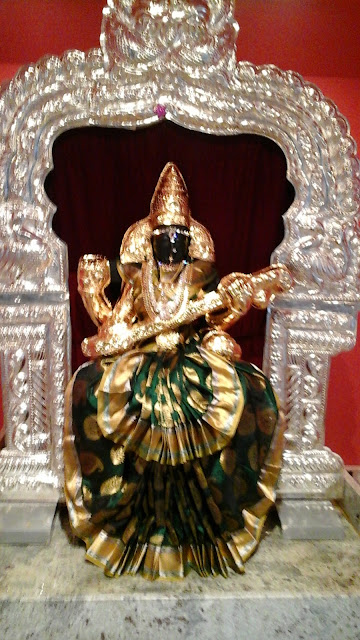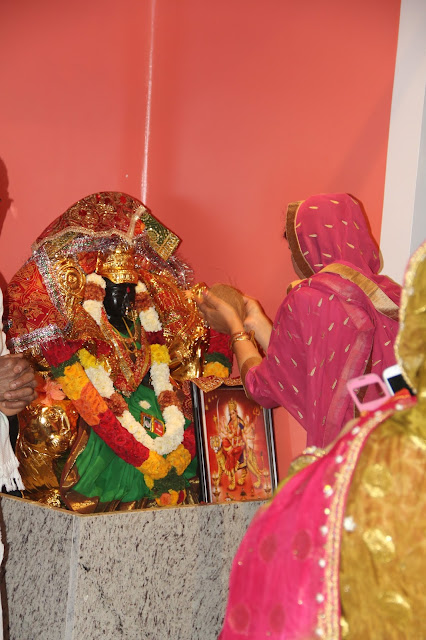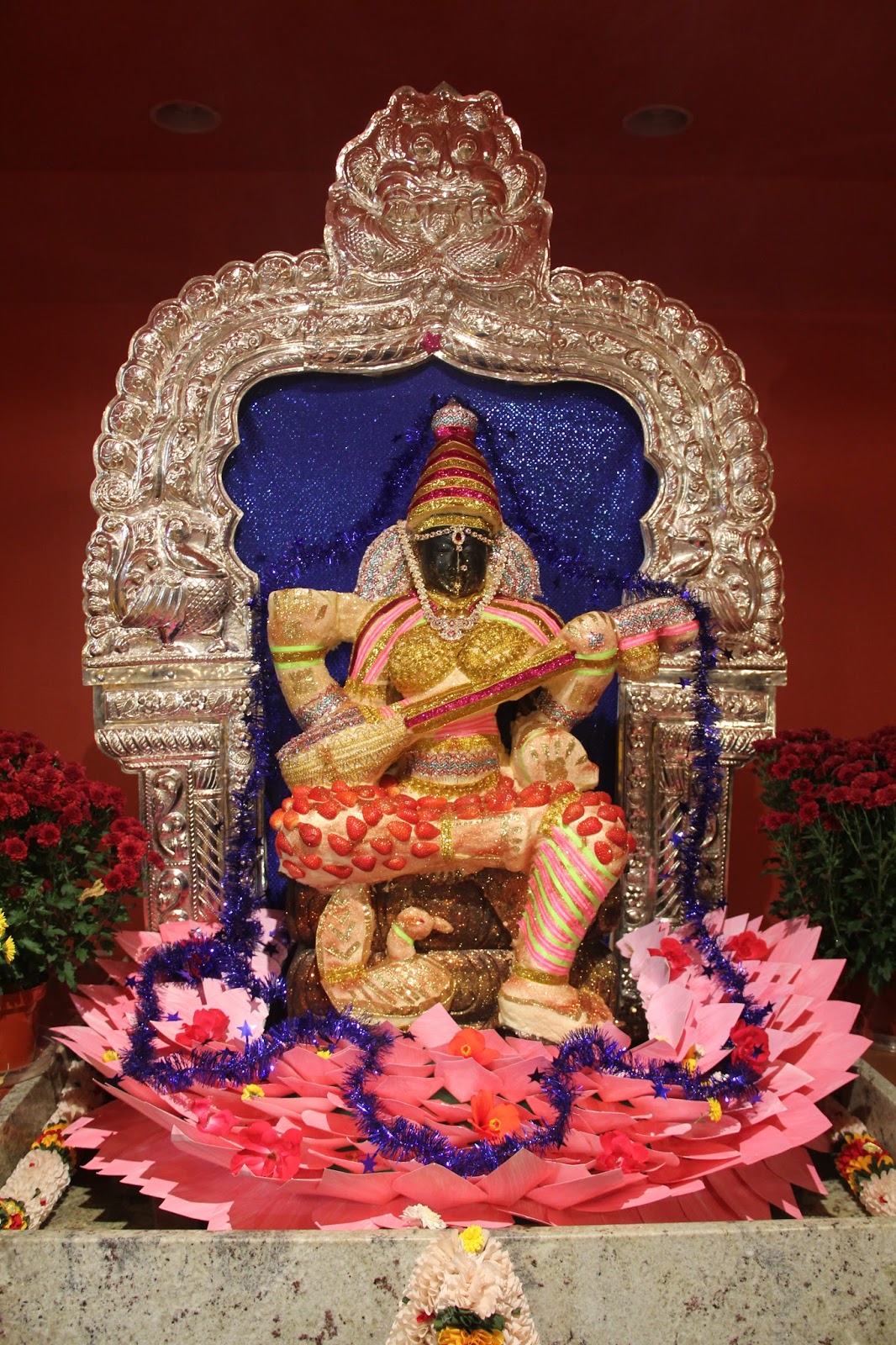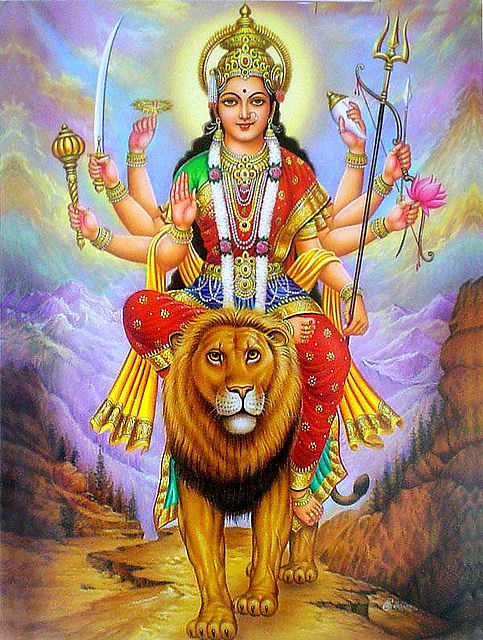Celebrate Navaratri at Chinmaya Saraswati Ashram
Devi Durga
Adopted from http://www.harekrsna.de/artikel/nava-durga.htm
Durga is one of the most
spectacular of all personifications of Cosmic energy. Devi, in her
'saumya' or benevolent form, looks serene and powerful. In her numerous
hands she holds a disc, mace, a sword, lotus, bow and an arrow, a
trident and a conch shell. Her many weapons underscore the idea that the
goddess incorporates the power of all the deities.
The background is mountainous, which is well thought of
since the word ‘Durga’, itself means insurmountable, and this is why too
most of the Devi’s temples are built atop hills. Durga (the goddess of power) is seated on a lion in a
fearless pose (Abhay Mudra) signifying assurance of freedom from fear.
Lion represents power, will and determination. She can be seen holding
her weapons (a long Trishula/trident with upper hand of right side and
lower hand of left side, a Chakra, a conch shell, a Mace, a
Talwar/longsword, a lotus and a bow) with her hands. She uses her
weapons to destroy evil and to produce an environment conducive to
growth of righteousness.
Nava Durga
'Nava'
means 'nine' All the nine names and forms of Durga are narrated in
‘Devi Kavacha’ of the ‘Chandipatha’ scripture by Brahma-deva Himself.
These forms are worshiped on each day of Navaratri.
Day 1: Śailaputrī
(Daughter of the Himālayas)
 |
| Also known as Sati Bhavani, Parvati or Hemavati, the daughter of
Hemavana - the king of the Himalayas, she is the first among Navadurgas.
Her worship takes place on the first day of Navaratri
– the nine divine nights. The embodiment of the power of Brahma, Vishnu
and Shiva, she rides a bull and carries a trident and a lotus in her
two hands. |
Day 2 Brahmachāriṇī
(One who observes the state of celibacy doing penance)
 |
| She is worshiped on the second day of Navaratri and is the second form of Mother Goddess.She enlightens us in the magnificent embodiment of Durga with great
powers and divine grace. She holds a rosary in her right hand and a
water utensil in her left hand. She is blissful and endows happiness,
peace, prosperity and grace upon all devotees who worship her. Filled
with bliss and happiness, she is the way to emancipation - Moksha. |
3.) Chandraghaṇṭā ( One who bears the moon in her necklace )
 |
| She is worshiped on the third day of Navaratri,
for peace, tranquility and prosperity in life. She has a ‘chandra’ or
half moon in her forehead in the shape of a ‘ghanta’ or bell. That is
why she is called ‘Chandraghanta’. She is charming, has a golden bright
complexion and rides a lion. She has ten hands, three eyes and holds
weapons in her hands. She is the apostle of bravery and possesses great
strength to fight in the battle against demons. |
4.) Kūṣmāṇḍa (the creator of the universe)
 |
| The fourth form of the mother goddess and is worshiped on the fourth day of Navaratri.
The meaning of the name ‘Ku-shm-anda’ is as follows: ‘Ku’ = a little;
‘ushma’ = ‘warmth’; ‘anda’ = ‘the cosmic egg’. So she is considered the
creator of the universe. The universe was no more than a void full of
darkness, until her light spreads in all directions like rays from the
sun. Often she is depicted as having eight or ten hands. She holds
weapons, glitter, rosary, etc., in her hands, and she rides a lion. |
5.) Skanda-Mātā (The mother of Skanda, Kārttikeya, born out of her powers)
 |
| The fifth aspect of the Mother Durga is known as ‘Skanda Mata’ - the
mother of Skanda or Lord Kartikeya, who was chosen by gods as their
commander in chief in the war against the demons. She is worshipped on
the fifth day of Navaratri.
She is accompanied by the Lord Skanda in his infant form. Skanda Mata
has four arms and three eyes, holds the infant Skanda in her right upper
arm and a lotus in her right hand which is slightly raised upwards. The
left arm is in pose to grant boons with grace and in left lower hand
which is raised also holds a lotus. She has a bright complexion and
often depicted as seated on a lotus. |
6.) Kātyāyanī (The daughter of sage Kātyāyana, who incarnated to help the Devas)
 |
| The sixth form of Mother Durga is known as ‘Katyayani’, who is worshiped on the six day of Navaratri.
The legend behind her name goes thus: Once upon a time, there was a
great sage called Kata, who had a son named Katya. Kata was very famous
and renowned in the lineage of saints. He underwent long austerities and
penance in order to receive the grace of the Mother Goddess. He wished
to have a daughter in the form of a goddess. According to his wish and
desire the Mother Goddess granted his request. Katyayani was born to
Kata as an avatar of Durga. |
7.) Kālarātrī (black as night, destroyer of Kālī)
 |
| This is the seventh form of Mother Durga and is worshiped on the seventh day of Navaratri.
She has a dark complexion, disheveled hair and a fearlessness posture. A
necklace flashing lightning adorns her neck. She has three eyes that
shine bright and terrible flames emanate from her breath. Her vehicle is
the donkey. Her raised right hand always seems to grant boons to all
worshipers and all her right lower hand is in the pose of allaying
fears. Her left upper hand holds a thorn-like weapon, made of iron and
there is a dragger in the lower left hand. She is black like Goddess
Kali and holds a sparkling sword in her right hand battle all evil. Her
gesture of protection assures us of freedom from fear and troubles. So
she is also known as ‘Shubhamkari’ – one who does good. |
8.) MahāGaurī (the wife of Lord Shiva, doing great penance)
 |
| She is worshiped on the eighth day of Navaratri.
Her power is unfailing and instantly fruitful. As a result of her
worship, all sins of past, present and future get washed away and
devotees get purified in all aspects of life. Maha Gauri is intelligent,
peaceful and calm. Due to her long austerities in the deep forests of
the Himalayas, she developed a dark complexion. When Lord Shiva cleaned
her with the water of the Ganges, her body regained its beauty and she
came to be known as Maha Gauri, which mean extremely white. She wears
white clothes, has four arms, and rides on a bull. Her right hand is in
the pose of allaying fear and her right lower hand holds a trident. The
left upper hand holds a ‘damaru’ (a small rattle drum) and the lower one
is in the pose of granting boons to her devotees. |
9.) Siddhidātrī (Provider of Siddhis, giver of mystic powers)
 |
| Siddhidatri is the ninth form of Goddess. She is worshiped on the ninth day of Navaratri.
Siddhidatri has supernatural healing powers. She has four arms and she
is always in a blissful happy enchanting pose. She rides on the lion as
her vehicle. She blesses all Gods, saints, yogis, tantrics and all
devotees as a manifestation of the Mother Goddess. In ‘Devi Bhagvata
Purana’ it is mentioned that Lord Shiva worshiped her and was blessed
with all Siddhis (supernatural powers). By her blessings his half body
became female and other half body male in the avatar of Ardhnarishvara. | |
